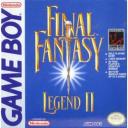Lost Classics: Final Fantasy Legend (Game Boy)
by William Talley, filed in Games, Lost Classics, Reviews on Mar.10, 2008
 This is pretty much a companion piece to my Final Fantasy I – VI special from two weeks ago. What makes this funny is that the Final Fantasy Legend series is actually the English translation of what is known in Japan as the Saga series. When Square released it over here, it changed the name to Final Fantasy Legend to capitalize off the growing popularity of the series. It has nothing to do with Final Fantasy, but then again it’s just as well, as none of the Final Fantasy games have anything to do with each other. Besides, these three games have managed to become excellent role-playing games in their own right.
This is pretty much a companion piece to my Final Fantasy I – VI special from two weeks ago. What makes this funny is that the Final Fantasy Legend series is actually the English translation of what is known in Japan as the Saga series. When Square released it over here, it changed the name to Final Fantasy Legend to capitalize off the growing popularity of the series. It has nothing to do with Final Fantasy, but then again it’s just as well, as none of the Final Fantasy games have anything to do with each other. Besides, these three games have managed to become excellent role-playing games in their own right.
While the early console Final Fantasy games centered around jobs such as black mage and thief, the Final Fantasy Legend games centered around your character’s race. In the first FFL, players could choose their party members from humans (who can wield heavy equipment but couldn’t use spells), mutants (who could only use light weaponry but was able to use spells), and one of four monsters (who have different abilities depending on which one you picked). Humans and mutants had their own separate way of building stats. Humans made use of potions which increased various attributes, and mutants increased them by making use of certain abilities and weapons, similar to Final Fantasy 2. If you had a monster in your party, then after certain battles you had the option to eat the meat of a fallen enemy and change form. It was a gamble, as your monster could become more powerful or weaker than its current form. This added some unpredictability to the game, and it was refreshing compared to other RPGs at the time.
FFL II and III expanded upon the system in some aspects, while simplifying it in others. In particular, Final Fantasy Legend 2 balanced out the differences between human and mutants. Humans could use finite-use spell books while mutants learned spells innately, and both races increased their stats in combat. In addition, players could now choose to play as robots, and members of this race were immune to paralysis and poison. Their stats were determined by the weapons and armor they had equipped. Final Fantasy III had race types predetermined at the start of the game. By installing parts and eating meat, player’s could change their characters into cyborgs and beasts, and eventually robots and monsters respectively.
In typical RPG sequel fashion, the plots of the three games have nothing to do with each other. The original FFL centered around a tower that supposedly led to paradise. FFL2 sent the player across several different worlds on a hunt for magi pieces, remnants of a broken statue. Each piece has its own magical power, and they can even be equipped by the player to give special abilities. FFL 3 sent the players throughout different time periods in order to prevent a disaster from destroying the world.
Along with raising the bar for Game Boy RPGs, these three games were the beginning of Square’s Romancing Saga franchise. Even though it wouldn’t see many releases over here, the Romancing Saga games were mentioned in the same breath as Final Fantasy. Sadly, the closest thing we would see to a re-release over here was when Sunsoft re-released the three games along with Final Fantasy Adventure (a.k.a. Seiken Densetsu) sometime in the mid 90s. These three games deserve a Nintendo DS/Sony PSP remake. It’s a shame that all we get from Square-Enix is re-releases of Final fantasy 1 and 2, as fans of the series will enjoy Final Fantasy Legend’s unique spin on the RPG genre.


 PS3
PS3
 Famicom Dojo
Famicom Dojo KEEP PLAYING
KEEP PLAYING KEEP PLAYING: Rewind
KEEP PLAYING: Rewind Powet Toys
Powet Toys Powetcast
Powetcast Hitchhiker's Guide POWETcast
Hitchhiker's Guide POWETcast














